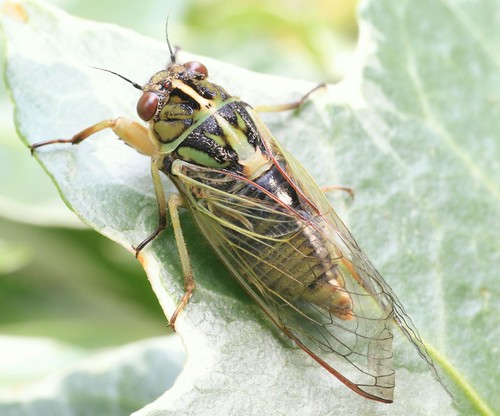There’s a new guidebook out for the cicadas of New Zealand. The book was produced by 10-year-old Olly Hills — proof that there are few age barriers to scientific interest and research.
Category: New Zealand
There’s a new paper from Sarah E. Banker, Elizabeth J. Wade, and Chris Simon titled “The confounding effects of hybridization on phylogenetic estimation in the New Zealand cicada genus Kikihia”.
Here are the highlights:
- Tested validity of an unexpected “Westlandica” mitochondrial clade with nuclear loci.
- Phylogenetic signal and pattern differ dramatically among nuclear genes but always weak on South Island.
- No conflict between nuclear concatenation vs species trees from multiple methods.
- Three nuclear species trees support major North Island but not South Island mitochondrial clades.
Here’s the citation information:
Sarah E. Banker, Elizabeth J. Wade, Chris Simon, The confounding effects of hybridization on phylogenetic estimation in the New Zealand cicada genus Kikihia, Molecular Phylogenetics and Evolution, Volume 116, November 2017, Pages 172-181, ISSN 1055-7903, https://doi.org/10.1016/j.ympev.2017.08.009.
(https://www.sciencedirect.com/science/article/pii/S1055790317302348)

There isn’t a lot of New Zealand cicada information on this website, but I wanted to point you to a few good resources if you are interested:
First, there’s the NEW ZEALAND CICADAS (HEMIPTERA: CICADIDAE): A VIRTUAL IDENTIFICATION GUIDE which features photographs and extensive information about the cicadas of New Zealand. The site has an abundance of information, and a wonderful design & layout.
Second, there’s Cicada Central’s New Zealand Cicada website, which features an electronic field guide of New Zealand Cicada Species, a specimen database, and a photo gallery featuring Kikihia, Amphipsaltas, and Maoricicada.
Third, iNaturalist is an excellent place to discover information about cicadas, and report sightings.
I asked David Marshall of InsectSingers.com, “when does New Zealand cicada season start and end?” His answer essentially is that it depends on the location, elevation, and species, but the best months are between December and April. Interestingly, in certain locations K. muta sing every month of the year.
Read the downloadable article Chorus Cicada, Amphipsalta zelandica (Boisduval), males calling with only wing-clicks by Kathy B. R. Hill, The Weta (2012) 43(1): 15—20, for more information.
Blog Posts
Websites
Flickr.com is an excellent source of cicada photos, and it is where I go for cicada photos from New Zealand. This is a sample of the cicada photos you will find on Flickr.com.
The colorful Amphipsalta zealandica:

Photo by Sid Mosdell. Auckland New Zealand. CC BY 2.0.

Photo by Nuytsia@Tas. Punakaiki, Paporoa National Park, New Zealand. CC BY-NC-SA 2.0.
Members of the genus Kikihia:

Photo by Rosino. Auckland, New Zealand. CC BY-SA 2.0.

Photo by aliceskr. New Zealand. CC BY-NC-ND 2.0.
Members of the genus Maoricicada:

Photos by Jon Sullivan. Auckland, New Zealand. CC BY-NC 2.0.

Photo by Jon Sullivan. Auckland, New Zealand. CC BY-NC 2.0.
Visit NEW ZEALAND CICADAS (HEMIPTERA: CICADIDAE): A VIRTUAL IDENTIFICATION GUIDE for in-depth information about the cicadas of New Zealand.
New Zealand cicada season
Cicada season in New Zealand begins in November and lasts throughout their Summer months.
Here is a list of the best New Zealand cicada links:
- New Zealand Cicadas (Hemiptera: Cicadidae): A virtual identification guide (landcareresearch.co.nz) A wonderful web site. Includes a visual identification guide, checklist, and image gallery. Photos of dozens of species. (updated 8/18/2024)
- Introducing cicadas (teara.govt.nz) Photos, sounds and 4 paragraphs of information.
- New Zealand cicadas (troutbum.co.nz)
Large photos of Kikihia and Amphipsalta. - Here is a nice article about the cicada Sounds of a Kiwi summer.
- A Flickr gallery of New Zealand Cicadas
Cicada Alphabet: K
K is for Dr. Kritsky, specifically Dr. Gene Kritsky of the College of Mount St. Joseph in Cincinnati, Ohio.
Dr. Kritsky is one of the premier Magicicada experts and advocates; if you’re a cicada fan you must attend one of his lectures and buy one of his books. A few years ago Gene provided Cicada Mania with an interview.
Kikihia, one of the two major Genus of cicadas in New Zealand. David Marshall says: “The name Kikihia is derived from the Maori word for cicada, as is the name of the town Kihikihi, in New Zealand. You’ll love their public cicada statue. See this web page: http://en.wikipedia.org/wiki/Kihikihi“.
The Kobonga is a Genus of cicadae that exists in eastern Australia. Thanks to David Marshall and Kathy Hill of InsectSingers.com for these wonderful photos of a Kobonga species currently nicknamed the Xmas Clanger (species name pending).